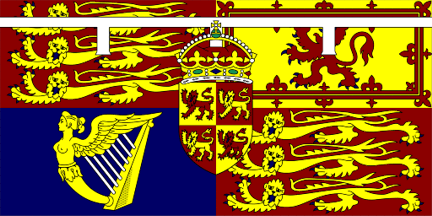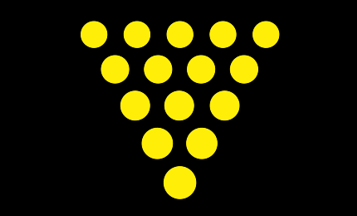 image
by Graham Bartram
image
by Graham Bartram
Last modified: 2011-07-08 by rob raeside
Keywords: royal standard | prince charles | queen elizabeth ii | prince of wales | duke of rothesay | duke of cornwall |
Links: FOTW homepage |
search |
disclaimer and copyright |
write us |
mirrors
Source: http://flags.net/UNKG02.htm
See also:
The standard of the Prince of Wales used in England is known from at least 1901. It is the Royal Standard with the white label with three pendants, with a heart-shield of Wales ensigned with a prince's coronet. Neubecker (1992) (originally published in 1939) leaves a blank spot where one would expect the flag, as the title was vacant in 1939. Evans (1970) shows 8 fleur-de-lys on the tressure flory-counter-flory; Politikens Flagbog (2000) and World Flag Database show 12 fleur-de-lys, for the most part obscured.
The Prince of Wales
web
page on standards states that there are three sizes: Royal Standard
proportion, "heraldic" proportion and "car".
Colin Dobson, 19 July 2005
According to the Prince of Wales web site, the rules for using the standards
are that the Prince of Wales's Personal Standard may be used on appropriate
occasions, except when he is visiting Scotland or Wales or the Duchy of
Cornwall, where the special standards are used. However, when he is visiting any
unit, station or ship of the Armed Forces, his Personal Standard is flown even
if the visit is within Wales or Scotland. It is not used during a private visit.
Source: Prince of Wales, website,
http://www.princeofwales.gov.uk, consulted 03 January 2007
Colin
Dobson, 3 January 2007
Unlike Princess Anne's Standard, which did not
change when she gained the title Princess Royal, the Standard of her older
brother Charles, which had been differenced with a plain white label of three
points, did change when he became Prince of Wales in 1958, and the Arms of Wales
ensigned with a Ducal Coronet were added. This is similar to the
1911 Standard of the Prince of Wales, except for the changes made to the Royal
Standard in the intervening period.
David Prothero, 2 May 2007
![[Prince of Wales Welsh standard]](../images/g/gb-w_pri.gif) by Marcus Schmöger, 12 November 2001
by Marcus Schmöger, 12 November 2001
As a personal standard for Wales, Prince Charles uses a square
banner-of-arms showing the traditional arms of Wales (quarterly of Or
and Gules, four lions passant counterchanged); on a green inescutcheon there is
a princely coronet.
Marcus Schmöger, 12 November 2001
The Prince of Wales
web
page says that the flag was first promulgated in 1962 and was flown for the
first time on 11 June 1969 at Cardiff Castle for the inauguration of the Royal
Regiment of Wales, of which The Prince was appointed Colonel-in-Chief on 1 July
1969.
Colin Dobson, 19 July 2005
This flag is normally ratio 1:1, except Politikens
Flagbog (2000) shows it as 2:3. The image in Evans (1970)
has the lions armed and langued crimson, or something like that. We have azure, like
World Flag Database, but I don't know whether it's actually specified.
Evans (1970) described green as "the Welsh
colour".
Peter Hans van den Muizenberg, 24 April 2002
The reference to green as a Welsh colour is probably in reference to the
livery colours of the Tudors which were green and white.
David Prothero, 27 April 2002
The Prince of Wales uses as a badge three feathers, with the motto "Ich
Dien" (I serve) below. There are several arguments about the origins of the three feathers and the
motto. Some claim that Edward the Black Prince, son of Edward III, adopted them after defeating
John of Luxemburg, King of Bohemia at Crecy. Other that the feathers come from his mother's
(Philippa of Hainault's) family. There is even a story
that the are a corruption of three lions with feathery tails!
Graham Bartram, 25 March 2002
The full list of Prince Charles' Scottish titles is H.R.H. The Prince
Charles, Duke of Rothesay, Earl of Carrick, Baron of Renfrew, Lord of the Isles
and Great Steward of Scotland.
Andrew Yong, 18 July 2002
The banner was designed in 1974 by Sir Iain Moncrieffe of That Ilk in his capacity as Albany Herald and approved by The Queen later that year. The standard, exclusively for use when The Prince is in Scotland, was first flown on July 21, 1976, when he visited Loch Kishorn, Wester Ross, to launch the Ninian Central oil platform production dock, the site of which was part of the ancient lordship of the Isles. The standard is also known as HRH's Scottish Banner.
The first and fourth quarterings of the banner - blue and white chequered
band across a gold background - represent the Great Steward of Scotland. The
second and third quarterings - a black galley with red flags on a white
background - represent the Lord of the Isles. Superimposed in the centre is a
small gold shield with the red Lion Rampant within a red Royal Tressure on it,
charged with a blue label of 3 points. This represents the Dukedom of Rothesay.
Source:
Prince of Wales website
located by John Griffith, 4 August 2003
"British Flags & Emblems" by Graham
Bartram confirms the comment about the
separate banner used by the Duke of Rothesay (Prince Charles).
Colin Dobson, 18 October 2004
 based on
World Flag Database
based on
World Flag Database
Black fifteen bezants, placed 5, 4, 3, 2, and 1. (Ratio 3:5) -
World Flag
Database
Peter Hans van den Muizenberg, 24 April 2002
See also: